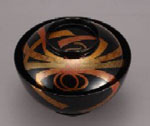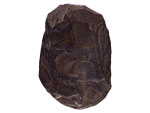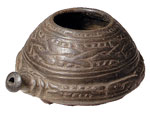The Mission of the Meiji University Museum
The Museum is divided into three departments, each having a distinct origin. The Commodity Department, the successor to the "Commodities Museum" considers lifestyles through commodities; and the Criminal Materials Department, follows in the footsteps of its predecessor the "Museum of Criminology" and contemplates law and human rights. The Archaeology Department, formerly the "Archaeological Museum", is concerned with humankind's past and diversity.
In this 21st century, we are embroiled in a myriad of problems. We hope some hint to overcoming them can be found in this museum.
Commodity Department - A Wealth of Traditional Designs
 Traditional lacquerware
Traditional lacquerware
 Bud vase in bamboo
Bud vase in bamboo
Criminal Materials Department - Law and People, Crime and Punishment
 The Iron Virgin of Nuremberg
The Iron Virgin of Nuremberg
 Old Japanese edict boards
Old Japanese edict boards
In the "Japan's Crime and Punishment" exhibition, there is a chronological display of a variety of historical laws.
In the "Culprits of the Edo Period", "Torture and Tribunal", "Execution and Correction" and "A Wealth of Criminal History" exhibitions, there are real artefacts that recount a history of suppressed human rights, including the devices used to catch criminals of Edo, and tools of torture and execution from Japan and other countries. In particular the guillotine and the Iron Maiden of Nuremberg are exhibits unique in Japan.
Through this type of criminological history, it is hoped visitors will be able to experience the world of crime and punishment, and gain a deeper appreciation of human dignity.
Archaeology Department - Humankind and History
 Stone axe
Stone axe
 Jomon ware
Jomon ware
For over fifty years, the Archaeological Department has compiled, documented and publicly exhibited the achievements of these kinds of research and surveys. The exhibition can perhaps be described as important materials that have stimulated Japan's post-war archaeology.
・Address
101-8301
1-1 Kanda-Surugadai, Chiyoda-ku, Tokyo, Japan
・TEL
03-3296-4448
・FAX
03-3296-4365
・URL
http://www.meiji.ac.jp/museum/


